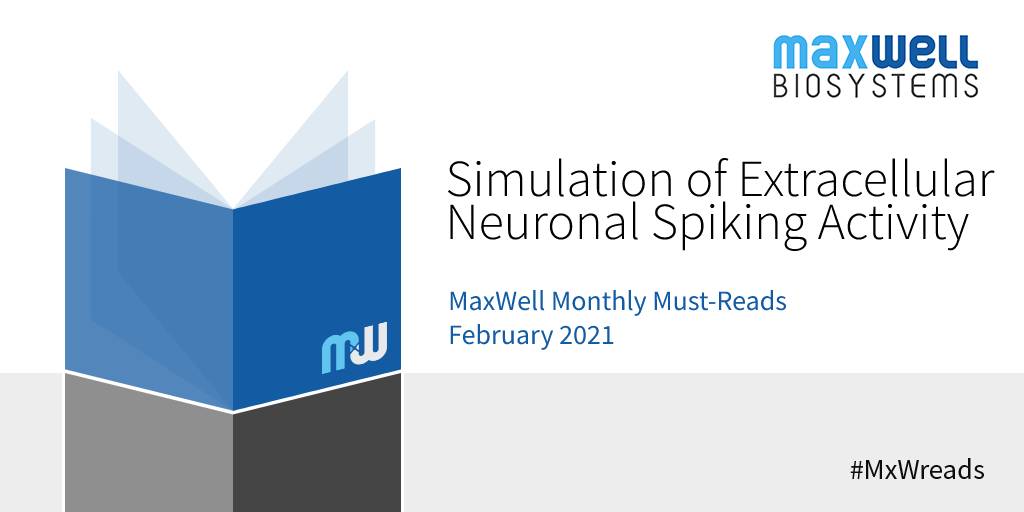Welcome to our MaxWell Monthly Must-Reads blog. As mentioned in our previous edition, we will, this year again, share with you 12 new monthly must-reads! Each month we will choose a theme and select five papers that we think are worth reading. Last month we focused on the topic of Functional Connectivity in Neuronal Networks. For our second edition, we are featuring the Simulation of extracellular neuronal spiking activity.
High-density microelectrode array (HD-MEA) devices feature hundreds to thousands of electrodes per millimeter square. In this scenario, the extracellular action potential of a single neuron is detected over multiple electrodes. Therefore, the electrical activity of neighboring neurons is mixed and recorded over adjacent electrodes. Spike sorting techniques enable de-mixing and classification of neuronal action potentials. However, when spike sorting of neuronal electrical activity is performed on HD-MEA data acquired either in-vitro or in-vivo, it is problematic to assess the quality of spike sorting algorithms due to lack of ground-truth data.
MEArec: A Fast and Customizable Testbench Simulator for Ground-truth Extracellular Spiking Activity.
by Alessio P. Buccino and Gaute T. Einevoll. Neuroinformatics. July 2020.
Buccino A.P. and Einevoll G.T. have developed MEArec, a customizable testbench simulator for ground-truth extracellular neuronal spiking activity, which enables the user to reliably test spike sorting algorithm. MEArec is a Python-based software which permits fast simulation of extracellular microelectrode array recordings. Extracellular action potentials are generated using biophysically realistic cell models, featuring 13 layer 5 cortical cell models from the Neocortical Microcircuit Portal. After simulation of extracellular action potentials, MEA recordings including spike trains can be generated, at desired electrode pitches. The software developed by Buccino A.P. and Einevoll G.T. aims to support the improvement and validation of spike sorting algorithms and to help understanding the limitation of state-of-the-art spike sorting methods.
Read the paper here.
Although we decided to highlight the article by Buccino et al., we selected four scientific articles that also delve into the simulation of extracellular neuronal spiking activity. These can be found below:
- Fast simulation of extracellular action potential signatures based on a morphological filtering approximation.
by Harry Tran, Radu Ranta, Steven L. Cam and Valerie Louis-Dorr. Journal of Computational Neuroscience. January 2020.
Read the paper here. - Systematic generation of biophysically detailed models for diverse cortical neuron types.
by Nathan W. Gouwens, Jim Berg, David Feng, Staci A. Sorensen, Hongkui Zeng, Michael J. Hawrylycz, Christof Koch and Anton Arkhipov. Nature Communications. February 2018.
Read the paper here. - SpikeInterface, a unified framework for spike sorting.
by . eLife. November 2020.
Read the paper here. - A Detailed and Fast Model of Extracellular Recordings. Neural Computation.
by . Neural Computation. May 2013.
Read the paper here.
We hope you enjoyed the second Monthly-Must-reads of the year! If you would like to be featured in one of the editions, feel free to contact us!
In case you would like to know how MaxWell Biosystems technology can help your experiments, please schedule a call with one of our specialists here: https://calendly.com/mxw
 English
English



